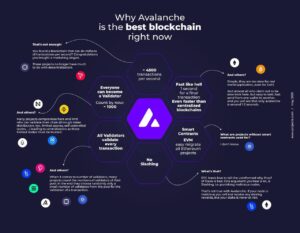Avalanche (AVAX) Explained
Avalanche is a blockchain platform that aims to address the blockchain trilemma of scalability, security and decentralization thanks to its unique Proof of Stake (PoS) mechanism.
Like Ethereum, Avalanche supports smart contracts to run decentralized applications (dApps) on its network. Since Avalanche’s smart contracts are written in the Solidity language also used by Ethereum, it aims to create greater blockchain interoperably by integrating a number of decentralized finance (DeFi) ecosystems, including well-established projects like Aave and Curve.
AVAX, the native token of the Avalanche platform, is used to power transactions in its ecosystem. AVAX serves as the means to distribute system rewards, participate in governance and facilitate transactions on the network by paying fees.
Who Created Avalanche?
In May 2018, Team Rocket — a pseudonymous group of software developers — published an article that detailed the basis for the Avalanche protocol. Soon afterwards, Emin Gün Sirer founded AVA Labs with the goal of creating and developing the Avalanche blockchain.
Sirer is a professor of computer science at Cornell University and was a notable member of the Initiative for Cryptocurrencies and Contracts (IC3). In 2003, he also created Karma, a Proof of Work virtual currency for peer-to-peer file sharing systems that predated Bitcoin.
Avalanche raised $42 million through an ICO in July 2020 and has continued to draw big investments since. In July 2021, the Avalanche Foundation held a token sale raising $230 million, with participants including large VC companies such as Polychain and Three Arrows Capital.
How Does Avalanche Work?
Although Avalanche’s platform is complex, there are three primary aspects of its design that distinguish it from other blockchain projects: its consensus mechanism, its incorporation of subnetworks and its use of multiple built-in blockchains.
Avalanche Consensus
In order for a blockchain network to validate transactions and remain secure, it must employ a protocol that allows its nodes to reach agreement — or consensus. With regards to cryptocurrencies, the conversation has centered around Proof of Work (PoW) vs Proof of Stake (PoS) as the leading methods for reaching this agreement.
Avalanche uses a novel consensus mechanism that builds on the PoS foundation. When a transaction is initiated by a user, it’s received by a validator node that samples a small, random set of other validators, checking for agreement. The validators perform this sampling procedure repeatedly, “gossiping” with each other to ultimately reach consensus.
In this way, one validator’s message is sent to other validators, which sample more validators, which sample even more validators – again and again, until the whole system reaches agreement on an outcome. Just as a single snowflake can become a snowball, a single transaction can eventually turn into an avalanche.
Validator rewards scale according to the amount of time a node has staked its tokens, called Proof of Uptime, and if the node has historically acted according to the software’s rules, called Proof of Correctness.
Subnetworks
Avalanche users can launch specialized chains that can operate using their own sets of rules. This system is comparable to other blockchain scaling solutions, like Polkadot’s parachains and Ethereum 2.0’s shards.
Consensus on these chains is reached by subnetworks (or subnets), which are groups of nodes that participate in validating a designated set of blockchains. All subnet validators must also validate Avalanche’s Primary Network.
Built-in Blockchains
Avalanche is built using three different blockchains in order to address the limitations of the blockchain trilemma. Digital assets can be moved across each of these chains to accomplish different functions within the ecosystem.
- The Exchange Chain (X-Chain) is the default blockchain on which assets are created and exchanged. This includes Avalanche’s native token, AVAX.
- The Contract Chain (C-Chain) allows for the creation and execution of smart contracts. Because it is based on the Ethereum Virtual Machine, Avalanche’s smart contracts can take advantage of cross-chain interoperability.
- The Platform Chain (P-Chain) coordinates validators and enables the creation and management of subnets.
Source URL ; https://www.kraken.com/en-us/learn/what-is-avalanche-avax
- PRwires
- Jordan Norway
- United States









